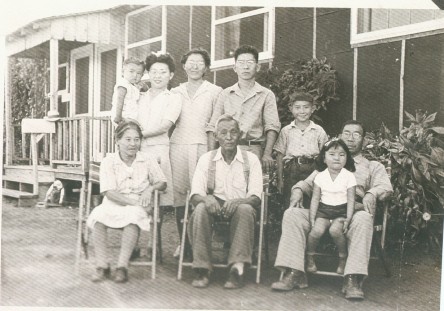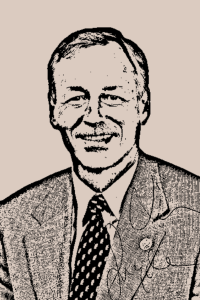Over 70 years have passed since one of Arkansas’s darkest chapters ended, but its effects are still felt around the country. When the Rohwer Japanese American internment camp in Desha County closed in 1945, the thousands of former inmates, from infants to the elderly, slipped quietly back into society after three years of traumatic exclusion. But their resilience and bravery left its mark on the camp—while interred, the families created monuments and built a cemetery to honor their loved ones. And today, in that tiny corner of Southeast Arkansas, those memorials still stand.

Japanese-American family outside of housing barracks at Rohwer Relocation Center in Desha County, Arkansas. Courtesy, UALR Center for Arkansas History and Culture.
For over 15 years, UALR has been involved in restoring the Rohwer cemetery and remembering the camp’s former residents—8,475 individuals in all. In the early 2000s, Professor of History Johanna Miller Lewis received funding from the Winthrop Rockefeller Foundation to undertake a major documentation and commemoration project for Rohwer and another Arkansas internment camp, Jerome. With the support of the Foundation, the Arkansas Humanities Council, and the Arkansas Natural and Cultural Resources Council, Miller documented the histories of Rohwer and Jerome; showcased four exhibits in Little Rock in partnership with the Japanese American National Museum in Los Angeles; created an hour-long documentary, Time of Fear, that included interviews with internees, their families, and local Arkansans who had lived near the camps; developed curriculum for grades four to twelve; and organized a two-day symposium, Camp Connections: A Conversation about Civil Rights and Social Justice in Arkansas, which was held in Little Rock in the fall of 2004.
The symposium’s attendees also visited Rohwer, which Lewis described as having “the most powerful sense of place I have ever encountered.” Over 1,500 people attended, a number of whom were former inmates, including Star Trek’s George Takei. While the visit impacted all involved, it also showcased the disrepair into which the site had fallen. Though Rohwer had been declared a National Historic Landmark in 1995, the monuments and headstones erected by the inmates had not been kept up. Lewis was struck by the gravity of this offense. She reported that one of the inscriptions on the cemetery monument in Rohwer reads “May the people of Arkansas keep in beauty and reverence forever this ground where our bodies sleep.” “Obviously, we weren’t doing that,” said Lewis.
Working towards Restoration
In 2004, Lewis spearheaded a major project to restore Rohwer’s memorials, with the support of substantial grants from the National Park Service. Since then, faculty, staff, and students from the UALR community have joined forces to document, preserve, and honor the diverse stories of Rohwer’s residents.
With this goal, the UALR Center for Arkansas History and Culture (CAHC) is working on two major Rohwer projects: Rohwer Restored and Rohwer Reconstructed: Interpreting Place through Experience. Both are funded by the National Park Service, with the latter being led by the University of Arkansas at Fayetteville. Associate Provost of UALR Collections and Archives Deborah Baldwin, CAHC Assistant Director Kimberly Kaczenski, and numerous scholars and staff members are working to ensure that not only is the physical site preserved, but so too are the former inmates’ personal artifacts and narratives.
On Rohwer Restored, Lewis is joined by Public History graduate student Danielle Butler, CAHC Director of Technology and Digital Initiatives Chad Garrett, and CAHC Archivist Shannon Lausch. This project continues Lewis’s efforts to restore Rohwer’s monuments and cemetery grounds while also documenting and exhibiting the process and the stories it brings to light. The resulting digital exhibit was designed, curated, and created by Garrett and Butler and will be continually updated as the restoration progresses. It includes a Gallery of Names for the cemetery, as well as pictures and historical information about the site.
Though his work with CAHC makes him no stranger to tough subject matter, Garrett stated that this project impacted how he thinks about the role of archiving. “I learned the value of saving the remnants of a dark time in the nation’s history both out of respect for the dead who are buried there and out of a sense of duty to remember so it doesn’t happen again.”
Rohwer Reconstructed, CAHC’s other related project, focuses on this vital preservation work; in the first phase, staff from CAHC and the University of Arkansas digitized over 500 documents, including photographs, newspaper clippings, and artworks created by the inmates. In late 2015, the project received funding from the National Park Service to continue its efforts, which are directed by U of A Principal Investigator Fred Limp. The UALR portion of the project is led by CAHC Multimedia Archivist Shannon Lausch, with Garrett, Mike Criswell, and a number of UALR graduate students assisting. The multi-university team plans to digitize over 1,800 items from more than 10 different collections currently housed at five Arkansas institutions, bringing them together into a single, publicly accessible online archive. They will also be creating an interactive 3D visualization of certain sections of the camp, with audio narratives based on survivors’ accounts integrated throughout.
Lausch, who selected CAHC’s contributions to the in-progress Rohwer Reconstructed archive, emphasized the lasting intellectual value of such a collection. “Once finished, it will be a wonderful compilation for anyone doing research about the internment camp. Whether it’s for genealogy or a student paper, users will readily be able to access a rich collection of primary sources without having to travel to various parts of the state.”
The highly interactive archive will be much more than just a gathering of materials—it will include navigation guides and contextual information to aid users. The leaders of the project want to make sure that users gain more than just historical facts, as they stated in their proposal: “While it is vital to remember the terrible injustice of Japanese-American internment, we must also recognize the spirit of those interned: their tenacity, their courage, and their accomplishments in the face of diversity.”
What’s Next?
The first and second phases of the Rohwer Restored project are complete—the monuments have been preserved, the headstones repaired, and the grounds equipped with a drainage system. The team will now pursue funding to rehabilitate the landscape to how it looked in the 1940s.
Rohwer Reconstructed received $245,608 from the National Park Service in October 2015, with UALR receiving $8,207 from this grant to continue its work. The project is expected to extend through at least September of 2017.
In both these efforts, UALR faculty, staff, and students join Rohwer survivors and organizations around the country that are striving to ensure that the legacies of thousands of Japanese Americans are never forgotten.
This article is featured in ORSP’s Research in the Rock magazine, along with other stories about research projects happening at UALR. Request a free copy of the magazine.

